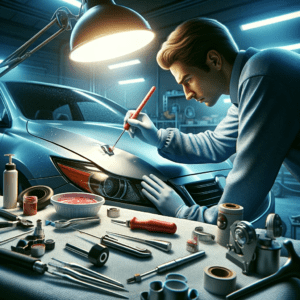Hail Damage Restoration with PDR (Paintless Dent Repair) Technique

When hail strikes, it leaves its mark not only on nature but also on our vehicles. Hail-induced dents can be a cosmetic nuisance and a reason for the depreciation in your vehicle’s value. In this context, the Paintless Dent Repair (PDR) method stands out as an innovative and effective solution. This technique not only preserves your car’s original paintwork but also offers a quick and economical alternative to traditional repair methods.
In this article, we’ll delve into how the PDR technology can restore your car’s aesthetics while maintaining its value. We’ll discuss the key steps in the hail damage repair process, focusing on the tools used, techniques, and advantages of this method over conventional approaches. The paintless approach not only protects your car’s factory paint but also presents a more eco-friendly repair option, reducing the need for chemicals and material reprocessing.
Beyond technical aspects, we’ll offer advice on choosing qualified PDR specialists and recognizing high-quality work. In today’s world, where a car’s appearance is so crucial, opting for PDR for hail damage repair is not just a practical choice but an investment in maintaining the appearance and value of your vehicle.
Whether you’re a car enthusiast or just looking to keep your vehicle in top condition, the insights in this article will help you understand why PDR is the preferred method for repairing hail damage and how it can assist in keeping your vehicle in pristine condition.
The Fundamentals of Paintless Dent Repair (PDR)


Paintless Dent Repair, also known as PDR, represents a revolutionary approach in automotive repair, efficiently removing dents and deformities without the need for repainting. This method focuses on preserving the car’s original paint, thus avoiding the additional costs and time associated with traditional repair methods.
At the heart of the PDR process is the use of specialized tools and techniques to gently reshape the metal surfaces without damaging the factory finish. The technique requires a high degree of skill and precision, and PDR specialists often undergo many years of training to master it. The main benefits of this method include rapid and effective car restoration, substantial cost savings compared to traditional methods, and a reduced environmental impact, as it doesn’t use paints or solvents.
Paintless dent removal is not just a repair method; it’s an art form. The technique demands a deep understanding of metallurgy and the physics of automotive materials, as well as a keen eye for detail. It’s crucial for the technician to assess the exact depth and size of the dent and apply the right pressure and movement to restore the metal to its original appearance.
PDR is particularly suited for repairing hail damage, as these deformations are usually superficial and do not affect the factory finish. This makes PDR the ideal choice for car owners who want to preserve the original look and value of their vehicles without compromising on repair quality.
In this section, we’ll explore in detail the key aspects and benefits of PDR, and how this method is becoming the preferred choice for modern automotive repair.
The Hail Dent Straightening Process


Straightening dents caused by hail is a process that demands precision, attention to detail, and a professional approach. In this section, we will examine the steps of this process, focusing on the key aspects that make Paintless Dent Repair (PDR) so effective and preferred.
Step 1: Damage Assessment – The first step in the PDR process involves a thorough evaluation of the damage. This includes inspecting the dents to determine their depth, size, and location. The assessment also considers factors such as the type of paint and metal, which are crucial in choosing the appropriate tools and techniques.
Step 2: Vehicle Preparation – After assessment, the vehicle is prepared for the straightening process. This involves cleaning the affected areas and ensuring access to the dents. In some cases, it may be necessary to dismantle parts of the vehicle for better accessibility.
Step 3: Tool and Technique Selection – Depending on the characteristics of the dents, specialized tools and techniques are selected. PDR specialists have a variety of tools, such as rods, hammers, and lighting systems, which help them to precisely visualize and correct deformations.
Step 4: Dent Straightening – The actual straightening of the dents is a process that requires careful attention and patience. The specialist gently manipulates the metal from behind, gradually returning it to its original shape. This requires exceptional precision and skill to avoid further damage to the paint and metal.
The PDR process for straightening hail-induced dents offers not only visually satisfying results but also preserves the structural integrity and original paint of the car. This makes this method the preferred choice for vehicle owners who value the appearance and worth of their mode of transportation.
Tools and Equipment for PDR
The art of Paintless Dent Repair (PDR) wouldn’t be possible without the specialized tools and equipment that enable technicians to make precise corrections on dents. In this section, we will examine the key tools and equipment essential for the successful rectification of hail-induced dents, highlighting how they contribute to the effectiveness and quality of the repair.
Straightening Rods: The core of PDR equipment are the straightening rods. They come in various sizes and shapes, allowing technicians to reach dents in all parts of the vehicle. Made from high-quality materials like stainless steel, these rods offer the combination of strength and flexibility needed to precisely straighten dents.
LED Light Panels: Adequate lighting is essential in PDR. LED light panels help technicians to see even the smallest details of the dent. This lighting is crucial for assessing the depth and success of the repair works.
Reflective Boards: Used to provide additional visualization of dents, reflective boards help to precisely determine the extent of the deformation and the effectiveness of the straightening.
Hammers and Tips: These tools are used for fine adjustments in repair work. Hammers and tips assist in restoring the metal to its original shape from the outside, while protecting the coating from damage.
Glue Systems: For certain types of dents, technicians use special adhesive tabs that are attached to the dent, then pulled out using specialized tools. This method is particularly useful when access to the back of the dent is limited.
Selecting the right tools and equipment is crucial to the quality of the PDR repair. In the hands of an experienced technician, these tools become a powerful means of restoring the vehicle to its pristine original appearance, while preserving the structural integrity and value of the vehicle.
Skills and Techniques for Effective Dent Straightening
In the world of Paintless Dent Repair (PDR), success depends not just on the tools and equipment, but also on the skills and techniques of the specialists. In this section, we will explore the key skills and crucial techniques for effectively straightening dents caused by hail, highlighting how they contribute to the quality and longevity of the repair.
Precision and Attention to Detail: The ability to work with precision is fundamental in PDR. Each dent requires a meticulous assessment and an individualized approach. The technician must have a keen eye for details to restore the metal to its original shape without damaging the coating.
Understanding of Materials: A deep knowledge of different types of metals and paints used in the automotive industry is essential. Various materials react differently to the PDR process, and the technician must know how to handle these differences.
Straightening Techniques: Effective straightening techniques involve using pressure and massaging to manipulate the metal back to its original shape. This requires a sense and experience, as excessive pressure can lead to additional damage.
Avoiding Common Mistakes: A key aspect of PDR is the ability to avoid typical errors such as overstretching the metal or damaging the paint. Experience and the ability to anticipate potential problems are important for achieving the best results.
PDR skills and techniques are the result of years of practice and training. In the hands of an experienced technician, these skills become a powerful tool for restoring the vehicle to its pristine original appearance. They are key to a quality and efficient repair of hail-induced dents, ensuring that your vehicle retains its value and appearance for years.
Practical Examples and Case Studies
Practical examples and case studies play a significant role in understanding the effectiveness and possibilities of the Paintless Dent Repair method. In this section, we will present real cases where PDR has been successfully applied to eliminate hail-induced dents, highlighting the transformation and results achieved through this innovative approach.
Case 1: Light Car with Multiple Hail Dents – In this case, a light car was affected by a severe hailstorm, leaving numerous small and medium dents on the hood and roof. Using specialized PDR tools and techniques, all the dents were successfully straightened, with the car regaining its original appearance without any trace of the previous damage.
Case 2: High-End Car with a Deep Dent – Here, a high-end car received a deep dent on the door, which would normally require traditional repair with painting. Thanks to PDR, the dent was carefully straightened, preserving the original paint and factory look of the car.
Case 3: Family Car with Complex Dents – In this example, a family car had several complex dents in different locations. Using a combination of straightening rods, LED light panels, and reflective boards, PDR specialists restored the surfaces to their ideal appearance, demonstrating the high precision and effectiveness of the method.
These examples illustrate how PDR can handle different types of hail damage, offering solutions that are both aesthetically pleasing and economically efficient. The application of PDR allows vehicle owners to maintain the original look and value of their cars, without needing costly and time-consuming repainting processes.
Conclusion: Embracing the Revolution of Paintless Dent Repair:
As explored in this article, Paintless Dent Repair (PDR) is a revolutionary method for restoring vehicles affected by hail-induced dents. This method not only preserves the original paint and appearance of the vehicle but also offers an effective, economical, and environmentally friendly solution for car owners. With its ability to restore metal to its original form without the need for repainting, PDR is the preferred choice of many owners wishing to maintain the value and appearance of their vehicles.
Straightening hail dents requires a high level of skill and precision, and using the right tools and techniques is essential for the success of the process. It’s also important to emphasize that choosing an experienced and qualified PDR specialist is crucial to ensure a high-quality outcome.
Call to Action:
If your vehicle has been affected by hail and you need professional assistance to restore its appearance, do not hesitate to contact us. Our PDR specialists are trained to work with the latest techniques and tools to ensure high-quality results that meet your expectations. Take advantage of our services to preserve the value and appeal of your car.
Contact us today for a free evaluation and consultation. Let us help you bring your vehicle back to its ideal state, while preserving its originality and value. Your satisfaction is our priority, and we are here to offer you the best in paintless dent repair.



